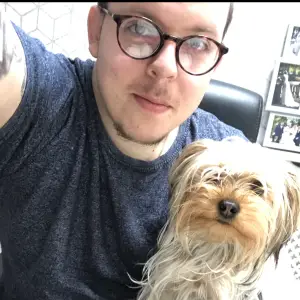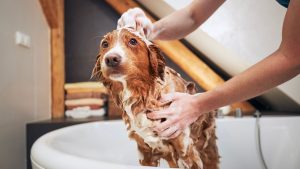If you’re a dog owner, you may have heard about the importance of expressing your dog’s anal glands. While this may seem like an unpleasant task, it’s crucial for your furry friend’s health. Anal glands are two small sacs located on either side of your dog’s anus that produce a foul-smelling liquid. Normally, these glands empty on their own when your dog defecates, but sometimes they can become blocked or infected, which can lead to discomfort, pain, and even infection.
Understanding how to express your dog’s anal glands is an essential part of pet care. Not only can it help alleviate discomfort and prevent infection, but it can also save you a trip to the vet. While it may seem daunting at first, with a little practice and patience, you can learn to express your dog’s anal glands at home. In this article, we’ll cover everything you need to know about expressing your dog’s anal glands, from understanding what they are and what causes problems to diagnosing and treating issues.
Key Takeaways
- Expressing your dog’s anal glands is an important part of pet care that can help prevent infection and alleviate discomfort.
- Anal glands are two small sacs located on either side of your dog’s anus that produce a foul-smelling liquid.
- Knowing how to express your dog’s anal glands can save you a trip to the vet and help keep your furry friend healthy.
Understanding Dog Anal Glands
Dog anal glands are two small sacs located on either side of the anus, just inside the rectum. These glands produce an excretion that is released during bowel movements, allowing dogs to mark their territory and communicate with other dogs through scent.
The anal glands are connected to the anus by small ducts, which are lined with muscle fibers that help to control the release of the excretion. When the glands are full, they can become impacted, causing discomfort and even infection. To prevent impaction, it is important to regularly empty the anal glands.
The process of expressing the anal glands involves manually squeezing the glands to release the excretion. This can be done at home or by a veterinarian. It is important to note that some dogs may not need their anal glands expressed regularly, while others may require more frequent expression.
Signs of impacted anal glands include scooting, licking or biting at the anus, and a foul odor coming from the area. If left untreated, impacted anal glands can lead to infection and other health issues.
In summary, understanding dog anal glands is important for maintaining your dog’s health and comfort. Regularly checking and emptying the anal glands can prevent impaction and associated health issues. If you notice any signs of discomfort or infection, it is important to consult with a veterinarian.
Causes of Anal Gland Problems
When it comes to anal gland problems in dogs, there are several factors that may increase the likelihood of a dog developing issues. Here are some of the most common causes of anal gland problems in dogs:
- Diet: A dog’s diet can play a significant role in the development of anal gland problems. Diets low in fiber can cause the stools to become too soft, which can make it difficult for the anal glands to empty properly. On the other hand, diets high in fiber can help promote regular bowel movements and may help prevent anal gland problems. Some high-fiber foods that may benefit a dog’s anal gland health include apples, pumpkin, and sweet potatoes.
- Allergies: Allergies can also play a role in anal gland problems. Dogs with food allergies or environmental allergies may be more prone to developing anal gland issues.
- Exercise: Regular exercise is important for a dog’s overall health, including their anal gland health. Exercise can help promote regular bowel movements, which can help prevent anal gland problems.
- Hypothyroidism: Hypothyroidism is a condition in which the thyroid gland does not produce enough thyroid hormone. In addition to other symptoms, dogs with hypothyroidism may be more prone to developing anal gland problems.
It’s important to note that not all dogs will develop anal gland problems, even if they have one or more of the above risk factors. However, knowing these risk factors can help pet owners take steps to prevent anal gland problems before they occur.
Symptoms of Anal Gland Problems
When it comes to anal gland problems in dogs, there are several symptoms that can indicate an issue. These symptoms can include:
- Scooting: Scooting is when a dog drags their bottom across the ground. This is usually the first sign that something is wrong with their anal glands.
- Licking or biting: If a dog is constantly licking or biting at their back end, it could be a sign of anal gland problems.
- Redness or swelling: Redness or swelling around the anus can also be a sign of anal gland problems.
- Fishy odor: A strong, fishy odor coming from your dog’s rear end is a clear indication that their anal glands are not functioning properly.
- Pain: Dogs with anal gland problems may also experience pain or discomfort when defecating.
If you notice any of these symptoms, it’s important to take your dog to the vet as soon as possible. Your vet can examine your dog’s anal glands and determine the best course of treatment. In some cases, the glands may need to be manually expressed to relieve the blockage.
It’s also important to note that some dogs may not show any symptoms at all, even if they have anal gland problems. That’s why it’s important to have your dog’s anal glands checked regularly by a vet, especially if they are prone to these types of issues.
Overall, being aware of the symptoms of anal gland problems in dogs can help you catch any issues early on and get your furry friend the help they need.
Diagnosing Anal Gland Problems
When it comes to diagnosing anal gland problems in dogs, it’s important to know what to look for. Some common signs of anal gland issues include scooting, licking or biting the area, and a strong, unpleasant odor. If you notice any of these symptoms, it’s important to take your dog to the vet for an examination.
During the examination, the vet may perform a rectal exam to check for any signs of infection, impaction, blockage, abscesses, tumors, or anal gland cancer. They may also take a sample of the gland’s contents for testing to determine if there is an infection present.
If your dog is diagnosed with an anal gland infection, the vet may prescribe antibiotics to treat the infection. In some cases, they may also recommend pain medication to help manage any discomfort your dog may be experiencing.
In the case of an anal gland impaction or blockage, the vet may need to manually express the glands to relieve the buildup of fluid. This is a procedure that should only be performed by a trained professional, such as a veterinarian or veterinary technician.
If your dog has an abscess, the vet may need to drain the abscess and prescribe antibiotics to treat the infection. In some cases, surgery may be necessary to remove the affected gland.
Overall, diagnosing anal gland problems in dogs requires a thorough examination by a veterinarian. If you suspect your dog is experiencing any issues with their anal glands, it’s important to seek treatment promptly to prevent any further complications.
Expressing Dog Anal Glands
Expressing dog anal glands is an important aspect of pet care that can help prevent discomfort and health issues for your furry friend. Here are some steps to follow when expressing your dog’s anal glands:
- Prepare the Materials: Before starting, gather all the necessary materials such as latex gloves, towels, and lubricant. It is also a good idea to wear old clothes that you don’t mind getting dirty.
- Position Your Dog: Place your dog in a standing position with their tail up. You can also have someone help hold your dog still if needed.
- Locate the Anal Glands: The anal glands are located on either side of the anus. You can feel for them by placing your thumb on the outside of the anus and your index finger on the inside and gently squeezing.
- Express the Glands: Once you have located the glands, gently squeeze them to express the fluid. You can use your fingers or a specialized tool to do this. Be sure to apply gentle pressure to avoid hurting your dog.
- Clean Up: After expressing the glands, clean the area with a towel and dispose of any materials used. You can also offer your dog some pumpkin to help soothe their digestive system.
Remember, if you are uncomfortable expressing your dog’s anal glands or if you notice any signs of infection or inflammation, it is best to seek the help of a veterinarian.
Preventing Anal Gland Problems
Preventing anal gland problems is crucial for maintaining your dog’s health and comfort. Here are some tips to help you prevent anal gland problems:
Diet
A high-fiber diet is essential to keep your dog’s anal glands healthy. Fiber helps to regulate bowel movements, which in turn helps to naturally express the anal glands. Some high-fiber foods you can include in your dog’s diet are sweet potatoes, pumpkin, green beans, and carrots. Make sure to introduce new foods gradually to avoid stomach upset.
Exercise
Regular exercise is crucial for your dog’s overall health, including their anal glands. Exercise helps to stimulate bowel movements, which can help to express the anal glands naturally. A daily walk or playtime in the yard can make a significant difference in keeping your dog’s anal glands healthy.
Pheromones
Pheromones can play a significant role in preventing anal gland problems. Pheromones are chemical signals that dogs use to communicate with each other. Using pheromone sprays or diffusers can help to reduce stress and anxiety in your dog, which can cause anal gland problems.
Sniffing
Dogs use their sense of smell to gather information about the world around them. Sniffing can also help to stimulate bowel movements, which can help to express the anal glands naturally. Letting your dog sniff around during walks or playtime can be beneficial for their anal gland health.
By following these tips, you can help prevent anal gland problems in your dog. However, if you notice any signs of anal gland problems such as scooting, licking, or foul odor, make sure to consult your veterinarian.
Cleaning and Treating Anal Gland Infections
When a dog’s anal glands become infected, it is important to clean and treat the area properly to prevent further complications. Here are some steps we can take to help our furry friends:
- Clean the area: We can clean the infected area with warm soapy water and a washcloth. This will help to remove any dirt or debris that may be trapped in the glands. It is important to be gentle and not apply too much pressure to the area, as this can cause pain and discomfort for our dogs.
- Partner with a vet: If the infection is severe or does not improve with at-home treatment, it is important to partner with a veterinarian. They may prescribe antibiotics or pain medication to help alleviate the pain and discomfort associated with the infection.
- Treat the infection: It is important to treat the infection to prevent it from spreading and causing further complications. We can use topical creams or ointments to help soothe the area and reduce inflammation.
- Prevent future infections: To prevent future infections, we can express our dog’s anal glands regularly. This can be done by a veterinarian, veterinary technician, or even some dog groomers. It is also important to ensure our dog’s diet is high in fiber and they are getting enough exercise.
By following these steps, we can help our furry friends recover from anal gland infections and prevent future complications.
Frequently Asked Questions
How to check if my dog’s anal glands are full?
We can check if a dog’s anal glands are full by gently pressing on the area around their anus. If there is a foul-smelling liquid or discharge, it may indicate that the glands are full and need to be expressed.
How can I relieve my dog’s anal glands?
We can relieve a dog’s anal glands by expressing them manually or by taking them to a professional groomer or veterinarian. We can also help prevent the glands from becoming full by adding fiber to their diet, ensuring they get enough exercise, and keeping their weight in check.
What are the signs of a dog’s anal glands being full?
The signs of a dog’s anal glands being full include scooting their rear end on the ground, licking or biting the area around their anus, and a foul smell emanating from the area. If the glands become infected, the dog may also experience pain, swelling, and redness.
What is the best way to help a dog express their anal glands?
The best way to help a dog express their anal glands is to have a professional groomer or veterinarian do it. Attempting to express the glands ourselves can be dangerous and may cause injury or infection. We can also help prevent the glands from becoming full by ensuring our dog gets enough exercise and adding fiber to their diet.
Can a female dog have anal glands?
Yes, female dogs have anal glands just like male dogs. However, they are generally smaller and less active than in male dogs.
Why do dogs have anal glands?
Dogs have anal glands to mark their territory and communicate with other dogs. The glands produce a unique scent that is released when the dog defecates. In some cases, the glands can become impacted or infected, causing discomfort and pain for the dog.
Author
-

Lawrence, the founder of Pet Ploy, established the website in mid-2023. With a lifelong love for pets, Lawrence has been surrounded by a variety of animals since his early years. From dogs and cats to guinea pigs, rabbits, fish, and more, he has experienced the joy of caring for a diverse range of pets. Drawing from his deep-rooted passion, Lawrence created Pet Ploy to share his knowledge and enthusiasm with fellow pet enthusiasts. Through the platform, he aims to provide valuable insights, tips, and resources to promote the well-being and happiness of pets everywhere.











